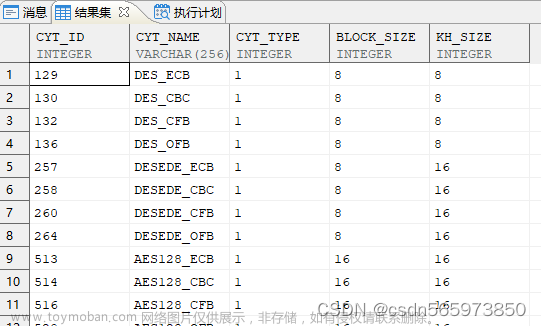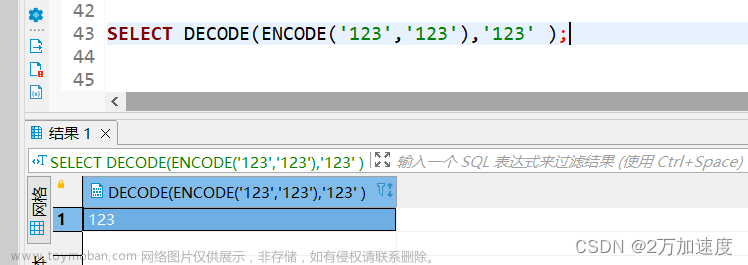前言
在现今互联网时代,数据安全已经成为了我们必须要面对的重要课题。对于Java开发人员而言,在实现数据库的加密时需要考虑到很多方面,比如性能、安全性、成本等等。在本篇博客中,我们将会介绍Java中常用的几种数据库加密方式,并解析它们的优缺点,以及适用的场景。我们将重点介绍以下几种加密方式:
- 对称加密
- 非对称加密
- 散列算法
下面我们将会详细地分别介绍这几种加密方式。
对称加密
对称加密是一种相对来说比较常用的加密方式,它的工作原理很简单:先用一个秘钥将明文加密成密文,再用相同的秘钥将密文解密成明文。其中最常见的对称加密算法有DES、3DES、AES。
对称加密的优点是加密解密速度快,因为它使用的是同一个秘钥进行加密和解密。但是它也有缺点,由于是同一个秘钥,一旦这个秘钥泄漏,整个加密系统就会失效。一旦数据被攻击者窃取,攻击者就可以使用这个秘钥进行解密。
下面为您提供对称加密的Java实现代码,使用的算法为AES:
import java.security.Key;
import javax.crypto.Cipher;
import javax.crypto.KeyGenerator;
import javax.crypto.spec.SecretKeySpec;
/**
* 对称加密工具类
*/
public class SymmetricEncoder {
private static final String ENCODE_TYPE = "AES";
private static final String ENCODE_RULES = "wxyKey_676767";
/**
* 加密
*/
public static byte[] AESEncode(String content) throws Exception {
KeyGenerator keygen = KeyGenerator.getInstance(ENCODE_TYPE);
keygen.init(128);
Key key = new SecretKeySpec(ENCODE_RULES.getBytes(), ENCODE_TYPE);
Cipher cipher = Cipher.getInstance(ENCODE_TYPE);
cipher.init(Cipher.ENCRYPT_MODE, key);
byte[] result = cipher.doFinal(content.getBytes());
return result;
}
/**
* 解密
*/
public static byte[] AESDecode(byte[] content) throws Exception {
KeyGenerator keygen = KeyGenerator.getInstance(ENCODE_TYPE);
keygen.init(128);
Key key = new SecretKeySpec(ENCODE_RULES.getBytes(), ENCODE_TYPE);
Cipher cipher = Cipher.getInstance(ENCODE_TYPE);
cipher.init(Cipher.DECRYPT_MODE, key);
byte[] result = cipher.doFinal(content);
return result;
}
}
非对称加密
与对称加密不同,非对称加密使用了公钥和私钥两个不同的秘钥。公钥是公开的用于加密,而私钥是保密的用于解密。非对称加密的常见算法有RSA。
与对称加密相比,非对称加密算法更安全,因为攻击者很难根据公钥破解密文。但是非对称加密的加解密速度相对较慢,因此不适用于大量的数据加密。
下面为您提供非对称加密的Java实现代码,使用的算法为RSA:
import java.security.*;
import javax.crypto.Cipher;
public class RSAUtil {
private static final String ALGORITHM = "RSA";
/**
* 公钥加密
*
* @param data 待加密数据
* @param publicKey 公钥
* @return
*/
public static byte[] encrypt(byte[] data, PublicKey publicKey) throws Exception {
Cipher cipher = Cipher.getInstance(ALGORITHM);
cipher.init(Cipher.ENCRYPT_MODE, publicKey);
return cipher.doFinal(data);
}
/**
* 私钥解密
*
* @param data 待解密数据
* @param privateKey 私钥
* @return
*/
public static byte[] decrypt(byte[] data, PrivateKey privateKey) throws Exception {
Cipher cipher = Cipher.getInstance(ALGORITHM);
cipher.init(Cipher.DECRYPT_MODE, privateKey);
return cipher.doFinal(data);
}
/**
* 生成密钥对
*
* @return
*/
public static KeyPair generateKeyPair() throws Exception {
KeyPairGenerator keyPairGenerator = KeyPairGenerator.getInstance(ALGORITHM);
keyPairGenerator.initialize(2048);
return keyPairGenerator.generateKeyPair();
}
}
散列算法
散列算法可以将任意长度的消息压缩成固定长度的摘要,常用的散列算法有MD5、SHA等。散列算法不同于对称加密和非对称加密,它不对原始数据进行加密,而是产生一个消息摘要。
对于散列算法来说,由于其不可逆的特性,几乎不可能通过摘要反推出原始数据。因此,散列算法常用于数据完整性校验,如密码的存储和校验等场景。
下面为您提供MD5摘要算法的Java实现代码:文章来源:https://www.toymoban.com/news/detail-471120.html
import java.security.MessageDigest;
import java.security.NoSuchAlgorithmException;
public class MD5Util {
public static String md5(String input) {
try {
MessageDigest md = MessageDigest.getInstance("MD5");
byte[] messageDigest = md.digest(input.getBytes());
StringBuffer hexString = new StringBuffer();
for (int i = 0; i < messageDigest.length; i++) {
String hex = Integer.toHexString(0xff & messageDigest[i]);
if (hex.length() == 1) hexString.append('0');
hexString.append(hex);
}
return hexString.toString();
} catch (NoSuchAlgorithmException e) {
throw new RuntimeException(e);
}
}
}
总结
到此,我们介绍了Java中常用的几种数据库加密方式,并提供了相应的实现代码和场景适用说明。开发人员应该在实现加密功能时,选择合适的加密方式来保证数据安全,同时也要注意加解密的性能和费用成本等因素的影响。文章来源地址https://www.toymoban.com/news/detail-471120.html
到了这里,关于Java中数据库加密的方式的文章就介绍完了。如果您还想了解更多内容,请在右上角搜索TOY模板网以前的文章或继续浏览下面的相关文章,希望大家以后多多支持TOY模板网!











